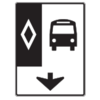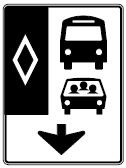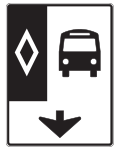 I ride a motorcycle and find that some HOV lanes allow motorcycles and some do not. It is frustrating to pass the non-HOV entrance to a roadway only to find that the HOV lane entrance does not permit motorcycles. Can it be changed so that motorcycles are permitted to use all HOV lanes and entrances, in particular that one as I commute over that bridge daily?
I ride a motorcycle and find that some HOV lanes allow motorcycles and some do not. It is frustrating to pass the non-HOV entrance to a roadway only to find that the HOV lane entrance does not permit motorcycles. Can it be changed so that motorcycles are permitted to use all HOV lanes and entrances, in particular that one as I commute over that bridge daily?
Road signs are something that we see every time we drive. Inside cities, there are often many signs that compete for our attention and it is important to know what they mean and how to recognize them at a glance.
Motorcycles in an HOV Lane
Unless prohibited by a sign, HOV lanes may be used by the operator of a cycle, motorcycle, taxi, handy dart vehicle or an electric motor vehicle.

Bus & HOV Only Lane Sign
After trading a few e-mails to gather more information, I learned that he had been stopped by police and warned that he could not operate his motorcycle in the lane that he had chosen because motorcycles were not permitted by the signs posted for it.
Bus Only Lanes
I contacted the police department involved and asked about this particular situation. They advised that the largest problem they faced with enforcement of HOV lane use was that many drivers did not understand the signs. Often they were operating in bus only lanes mistakenly thinking that they were HOV lanes.

Bus Only Lane Sign
Symbols on the Signs
This turned out to be the case here. The rider thought that the black rectangle with the white diamond on it meant HOV instead of a restricted lane. One has to identify the permitted use of the restricted lane by interpreting the symbols on the sign with the diamond.
In his case it showed only a bus, making it a bus only lane. The presence of a car would have identified it as a bus and HOV lane that motorcycles would have been allowed to use.
Making Changes
How does one make changes to the designated lane uses? That would depend on who has responsibility for that particular part of the highway. If it is in a municipality, inquire with the municipal council. Otherwise the Ministry of Transportation and Infrastructure is in charge of the designation.
Take the Test
Do you think that you could get 25 out of 25 on a BC road sign recognition test? Give it a try and see.
For information on Reserved Lane Signs visit page 32 of the RoadSense for Drivers manual.
For information on Reserved Lane Use visit page 52 of the RoadSense for Drivers manual.
Share This Article
Quite correctly many drivers/riders fail to understand the difference between HOV and BUS lanes. The distinction is well explained.
Perhaps what is not understood by most drivers is the reasoning for permitting motorcycles in HOV lanes. This has nothing to do with vehicle occupancy. Rather, it was based upon arguments taken to the BC Legislature about safety by the BC Coalition of Motorcyclists (BCCOM).
A great danger to a motorcyclist is a driver who fails to do a shoulder or even a mirror check before doing a lane change. Since it is illegal to cross a solid white line, a vehicle within an HOV lane is protected from the "lane jumper" so long as the lane border is a solid line. Only where the lane border is a broken line, is a vehicle permitted to enter or leave an HOV lane. By this reasoning, a motorcyclist is "protected" except where the border line is broken.
Of course it doesn't work in practise for several reasons. Many drivers are ignorant of the "Do Not Cross a Solid Line" rule. There is little or no enforcement except perhaps after a crash. Any motorcyclist who relies upon a driver to be competent, is a fool.
But that is the reasoning and most North American jurisdictions permit motorcycles in HOV lanes because of it.
- Log in to post comments
- Log in to post comments

Motorcycles in HOV lanes